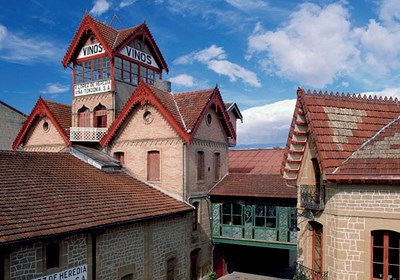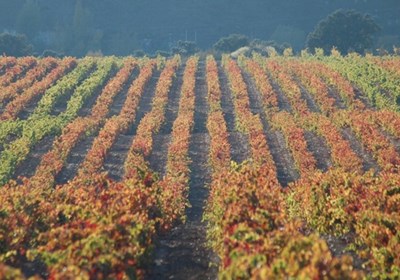
Which site would you like to visit?
By clicking the retail or wholesale site button and/or using rarewineco.com you are choosing to accept our use of cookies to provide you the best possible web experience.





A decade or so ago, Traditional Rioja seemed to be on the verge of extinction, beaten into submission by the “International” winemaking trend that has swept the region for more than thirty years.
But, today, Traditional Rioja is making a strong comeback, as connoisseurs come to realize that the sumptuous CUNE Viña Reals and Lopez Tondonias and Bosconias from the 1940s to the 1970s are among the planet’s greatest wine treasures. And the recent rise to stardom of the relatively young, but staunchly traditional, Hermanos Peciña, offers compelling evidence of the world’s growing love affair with Rioja as it was once made.
Yet, it’s often forgotten that what we know as “Traditional Rioja” is less than 150 years old, having been created in the wake of Phylloxera in the late 1800s. Before that, an earlier tradition flourished that featured viticulture and winemaking on a far smaller scale, allowing vine-by-vine attention to fruit quality, and the inclusion of stems during fermentation and shorter time in larger barrels.
Since 2014, the husband-wife team of Oscar Alegre and Eva Valgañón have embraced this even more ancient tradition. By working strictly with tiny lots, they are turning out head-spinning reds and whites that capture the best of their beloved land’s 1,000+ year history. And, their wines informed by this ancestral wisdom, are offering something unique in today’s Rioja landscape.
The “traditional” era developed after the phylloxera root louse swept through France in the 1860s. Frenchmen looked to Spain to supply their wineries, and soon the méthode bordelaise had conquered Rioja. Production was on a large scale, with wines kept in small barrels (usually the 225L barrique) until sold. At the time, barrel-grade European wood was difficult to come by, and expensive, so the Riojanos turned to America’s vast forests for cheap wood. The American oak gave the wines a uniquely sumptuous texture.
Of course, Rioja had a long winemaking history prior to the arrival of phylloxera. Grape cultivation arrived during Roman times, and—just as in France—monasteries were instrumental in codifying the best vineyards and varieties. The local Riojas were often fermented with their stems, and the quality of one’s grapes was a point of pride. Yet, this intimate knowledge of the land and its local cultivars slowly dissipated as the large houses grew ever larger, and the majority of grape growers were paid by the tonnage they produced.
While Oscar and Eva have only been producing wine since the 2014 vintage, their ideas developed over a period of years. They met while studying enology in Italy, and they eventually married. After returning to Spain, Eva found work as a winemaker and Oscar worked in export for some of Spain’s most famous producers. Both families own prime vineyards, and the young couple always held the dream of crafting their own wine from them.
In his export roles, Oscar traveled throughout Europe, and was exposed to many of its ancient wine traditions. A particularly eye-opening 2007 trip to the Rhône and Piedmont brought visits to luminaries like Allemand, Rostaing, Giuseppe Rinaldi, both Mascarellos, and Giacomo Conterno. That trip reframed for Oscar how he might approach own wines ... someday. He saw how dedicated winemakers could reinvigorate their region’s traditions in the face of “modern” or “international” winemaking.
The turning point came, however, in 2012, when Oscar traveled with us on a weeklong trip to interview surviving winemakers from Traditional Rioja’s ‘Golden Age’ (1940s-1970s). These old-timers had retained incredible knowledge about where the best vineyard sites were, how blending varieties and sites could yield a more compelling final wine, and how the stems in old wines imparted freshness and character.
But by the time of these interviews, it was already too late: most of their bodegas had turned away from tradition. On the positive side, they practiced more serious viticulture. But their newly adopted cellar methods gave a more international feel to the wines.
It became clear to Oscar and Eva that there could be another path forward in Rioja—an approach that married the best of Traditional Rioja with a deeper appreciation of Rioja’s even more ancient ancestral past.
The basis of any great wine estate is, of course, its vineyards. And many of Oscar and Eva’s family vineyards lie just to the west of Haro, in the shadow of the Obarenes Mountains. This area has long been revered by producers for the freshness and persistence they provided in blends. In fact, one old-timer claimed that the esteemed early Viña Reals were usually a blend of 75% Obarenes Tempranillo, with up to 25% Garnacha from Cárdenas. Having vineyards in both villages, Oscar and Eva’s are able to work with similar proportions for their signature tinto.
To get the most of their families’ vineyards, they worked to institute better farming, and by 2013 they were committed to sustainable agriculture. Oscar had seen how the inclusion of ripe stems during fermentation gave Rhône Valley wines greater purity and expressiveness. His research showed that earlier generations in Rioja had also used stems in their musts, and this too became part of their concept.
They also confronted the question of barrel aging. Traditional Rioja wineries have of course relied on American oak for aging, while their more modern peers shifted to French oak, often with a percentage that’s new.
Because Oscar and Eva’s quest was to develop a wine that’s a product of their land, they chose to minimize the effect of wood. To this end, they started their project with a mix of used French barriques and demi-muids. Because French wood loses its flavoring ability much faster than does American oak, they’ve been able to minimize the flavor impact of the wood. And as the project develops, they hope to adopt longer aging and even bigger neutral barrels.
For now, Alegre Valgañón is releasing just two wines, a Blanco and Tinto. There may be an old-style Clarete down the line, and the couple hopes to eventually develop a long-aged, large-barrel wine that would take lessons from Barolo and Rioja’s old Gran Reservas.
As Oscar has said, “We are not trying to make the greatest wine in Rioja. We only want to make a true wine—a wine that shows off our land, and all the knowledge that we’ve inherited from earlier generations.” This philosophy is very similar to that of another RWC producer, Maria Teresa Mascarello, and it’s not a coincidence that both estates’ wines have such striking identities.
The humility and long, painstaking gestation of the project may too explain why we believe that Oscar’s and Eva’s project ranks among the most exciting in Rioja today.
| Year | Description | Size | Notes | Avail/ Limit |
Price | |
|---|---|---|---|---|---|---|
 2022
2022
|
2022 Alegre Valgañón Rioja Blanco |
LG92+ / JS94 / VM91 |
12 | $22.95 | add | |
 2021
2021
|
2021 Alegre Valgañón Rioja Tinto |
LG93+ / JG93 / JS93 |
12 | $22.95 | add |
 Article
Article
 Press
Press
 PRODUCER
PRODUCER
 Article
Article
 Article
Article
 Article
Article
 Article
Article
 PRODUCER
PRODUCER
 PRODUCER
PRODUCER
 PRODUCER
PRODUCER
 PRODUCER
PRODUCER
 PRODUCER
PRODUCER
 PRODUCER
PRODUCER
 PRODUCER
PRODUCER
 PRODUCER
PRODUCER
 PRODUCER
PRODUCER

New discoveries, rare bottles of extraordinary provenance, limited time offers delivered to your inbox weekly. Be the first to know.
Please Wait
Adding to Cart.
...Loading...


By clicking the retail or wholesale site button and/or using rarewineco.com you are choosing to accept our use of cookies to provide you the best possible web experience.

